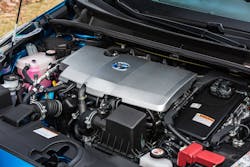March 12, 2020—When the Hybrid Electric Vehicle graduate program at Michigan Technical University Started a decade ago, joint internal combustion and electric powertrains were all the rage.
Now fully electric vehicles have entered the light-duty vehicle market, but that doesn’t mean hybrids have waned in popularity. There are more models than ever before, which makes for interesting work at the Michigan Tech program.
“I think there are new challenges all the time in vehicle electrification, whereas the first vehicles were mostly hybrids, now a larger and larger fraction become EVs,” says Jeff Naber, the graduate program director.
As the number of hybrids and EVs has grown, so has the number of engineers working on them. That’s the target student for the Michigan Tech program, which has both graduate certificate and professional development coursework.
While fully electric vehicles get a lot of press, hybrids aren’t going away. And that’s reflected in the popularity of the program.
“I think our demand is as strong as ever,” he says.
Electrification Grows
Naber says that as the market shifts more toward battery-electric vehicles, engineers are interested in maximizing battery power. This is particularly important when a vehicle doesn’t have an internal combustion engine to rely upon—like a hybrid has—for things like heat.
“Energy management and even things like heating and cooling the passenger compartment and the cooling of the battery pack become really critical subsystems,” he says.
The range in an EV is affected by how much power is needed for those subsystems.
While the engineering evolves in the EV world, Naber says that he expects hybrids to remain a big part of the light-duty market, even as OEMs signal that they’re looking toward a fully electric future.
“I expect there’s going to be a broad portfolio of offerings,” he says.
Naber says that they’re working to train for the future—whichever way the industry trends move.
“I think we’ll continue to follow what our partners are looking for,” he says. “They’re building lots of EVs, and I don't know that the consumers have decided yet what’s going to win.”
Image: Toyota






